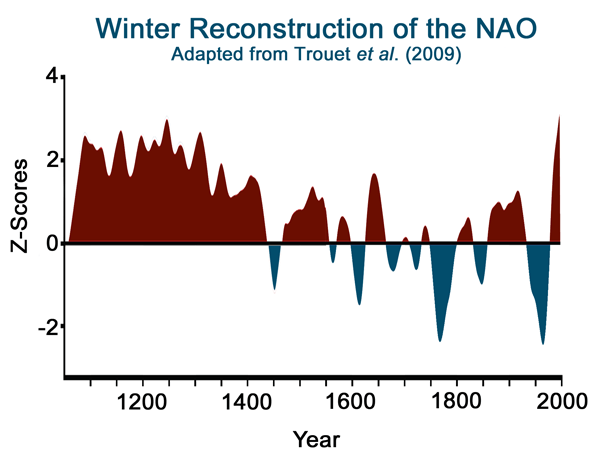Volume 12, Number 27: 8 June 2009
In a paper recently published in Science, Trouet et al. (2009) tell how they constructed a 947-year history (AD 1049-1995) of the North Atlantic Oscillation (NAO), using a tree-ring-based drought reconstruction for Morocco (Esper et al., 2007) and a speleothem-based precipitation proxy for Scotland (Proctor et al., 2000). This history begins in the midst of what they call the Medieval Climate Anomaly (MCA), which they describe as "a period (~ AD 800-1300) marked by a wide range of changes in climate globally [our italics]," which interval of medieval warmth, as they describe it, is "the most recent natural counterpart to modern warmth and can therefore be used to test characteristic patterns of natural versus anthropogenic forcing."
The results of their work are portrayed in the figure below, where it can be seen that the peak strength of the NAO during the MCA was essentially equivalent to the peak strength the NAO has so far experienced during the Current Warm Period (CWP), which finding suggests to us that the peak warmth of the MCA was also likely equivalent to the peak warmth of the CWP.

So what is the scenario that Trouet et al. propose for the development of medieval warmth throughout Europe? Very briefly, they say "the increased pressure difference between the Azores High and the Icelandic Low during positive NAO phases results in enhanced zonal flow, with stronger westerlies transporting warm air to the European continent," to which they add that "stronger westerlies associated with a positive NAO phase may have enhanced the Atlantic meridional overturning circulation (AMOC)," which in turn may have generated "a related northward migration of the intertropical convergence zone."
But what initiated these phenomena? Trouet et al. write that "the persistent positive phase [of the NAO] reconstructed for the MCA appears to be associated with prevailing La Niņa-like conditions possibly initiated by enhanced solar irradiance and/or reduced volcanic activity and amplified and prolonged by enhanced AMOC," which is not at all implausible, especially in light of the many paleoclimate studies that have identified cyclical solar activity as the primary cause of various climate cycles here on earth (see everything listed under Solar Influence in our Subject Index).
The six scientists thus conclude their paper by writing that "the relaxation from this particular ocean-atmosphere state [that of the MCA] into the Little Ice Age appears to be globally contemporaneous and suggests a notable and persistent reorganization of large-scale oceanic and atmospheric circulation patterns [our italics]." Consequently, it is equally reasonable to suggest that the reversal of this process -- i.e., the reinstatement of the particular ocean-atmosphere state that characterized the MCA -- may well be what has led to the globally contemporaneous development of the Current Warm Period. And this scenario suggests that the planet's current level of relative warmth may well be due to processes originating in the sun, which are therefore are not attributable to man.
Sherwood, Keith and Craig Idso
References
Esper, J., Frank, D., Buntgen, U., Verstege, A., Luterbacher, J. and Xoplaki, E. 2007. Long-term drought severity variations in Morocco. Geophysical Research Letters 34: 10.1029/2007GL030844.
Proctor, C.J., Baker, A., Barnes, W.L. and Gilmour, M.A. 2000. A thousand year speleothem proxy record of North Atlantic climate from Scotland. Climate Dynamics 16: 815-820.
Trouet, V., Esper, J., Graham, N.E., Baker, A., Scourse, J.D. and Frank, D.C. 2009. Persistent positive North Atlantic Oscillation mode dominated the Medieval Climate Anomaly. Science 324: 78-80.




